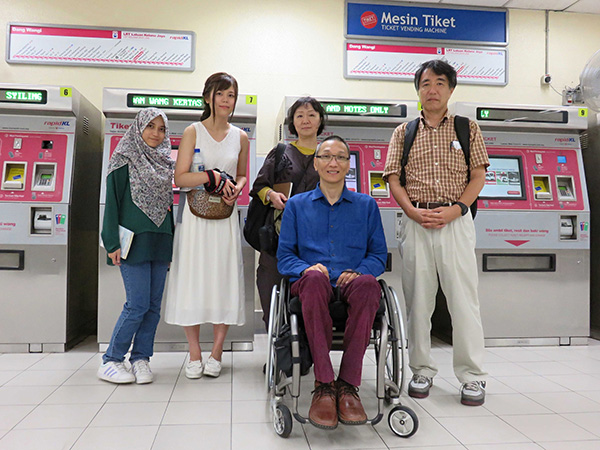
The writer with Satoh (right), Hashimoto (second right) and architecture students from Japan at the Dang Wangi LRT Station.
TWO professors in architecture from Japan were in Malaysia to learn about the “non-handicapping environment” in Kuala Lumpur earlier this week. They were Katsushi Satoh of Japan Women’s University and Hiroko Hashimoto of Oyama National College of Technology. Hashimoto was accompanied by two of her students, one of whom is a Malaysian currently studying with her.
We met at KLCC Suria over the National Day holiday and talked about the situation in Malaysia. They wanted to understand the roles of disabled people and our participation in the process of making the environment accessible, and the various issues and obstacles that we face in this area. Apart from finding out from users, they also arranged to meet with other stakeholders, namely architects and officers from city hall for the same purpose.
Satoh was here in 2009 and was back this time for a follow-up study. He noted that there were improvements in the facilities for disabled people. That I agreed with him. However, I also mentioned that the improvements were on a piecemeal basis and isolated, and not enough to allow disabled people to use the facilities independently, conveniently and safely.
Having walked around earlier, they were very curious about the non-working elevators at the monorail stations. They could not understand why the elevators were left idle like that because in Japan, disabled people and the senior citizens who had to use these facilities would have complained persistently and incessantly until the elevators were in working order again.
The reasons I could offer were that the elevators had broken down and were not repaired or were intentionally locked for one reason or another. As the surrounding areas were not accessible, not many disabled people use the monorail, preferring other modes of transport to move around to avoid the hassle of being stranded.
We had planned to walk around KLCC to observe the barrier-free conditions after the meeting. Unfortunately, it was raining heavily. We decided to take a short trip on the Kelana Jaya Line from KLCC to Dang Wangi instead, which was two stops away. The Kelana Jaya Line is a light rail transit (LRT) system passing underneath the KLCC.
To get down to the station, I had to use a stairlift. When we got there, a long queue of prams was waiting to use the lift, which only had space to accommodate one user at a time. A bollard installed at the path to the escalator allowed only walking pedestrians to use it while blocking prams. We waited for a good 10 minutes for my turn. I was consoled by the fact that it was working. I was told by friends it breaks down frequently.
Being a public holiday, there were many commuters at the station. I bought my ticket in the form of a token coin from the manned counter at 50 per cent off. This discount is extended to all disabled persons holding the Kad OKU. The rest of our party got their token coins from the automatic ticket vending machine.
The train and the platform was of the same level. There was a small gap in between that could trap the front wheels of my wheelchair if I was not careful. A man who was on my right offered to help as I was about to get into the train. My wife and I politely declined. Having taken the train several times previously, I knew I could pop a low wheelie by myself to lift my front wheels up and across the gap effortlessly to get into the train.
As I did that, I felt my wheelchair tipping backwards. Unbeknown to me, the man who had offered to help earlier was holding on to one of my wheelchair’s push handles. That prevented my wheelchair from moving forward and caused it to tip backwards. If not for the quick reaction of my wife, I would have been thrown off the wheelchair. That is why no one should hold on to any part of a wheelchair without the user’s knowledge. It could cause an untoward and serious accident.
Each train has one coach with wheelchair space allocated. However, there was no external indication such as a sticker to indicate which coach has this facility. I got into one without the space and had to squeeze awkwardly in between other passengers in the packed train.
The ride itself was uneventful. After all, the Kelana Jaya Line was built with accessibility in mind from the very beginning. It was the first rail line in Malaysia that disabled people could ride from end to end without problems. In spite of this, the moment we got out from the stations, we have to struggle with a host of barriers.
We parted ways at Dang Wangi Station and agreed to keep in touch. I hope I provided a clear picture of the barrier-free situation or lack of it in Malaysia to them. I was embarrassed and disappointed to have to share the many deficiencies when it comes to facilities for disabled people, especially to guests from overseas.
We have had so many opportunities to make it better but failed to capitalise on them. I hope the authorities wake up from their slumber. My shame should be their shame as well, more so because they have the means and resources, and are responsible for making facilities that everyone can use but have not lived up to that expectation.
